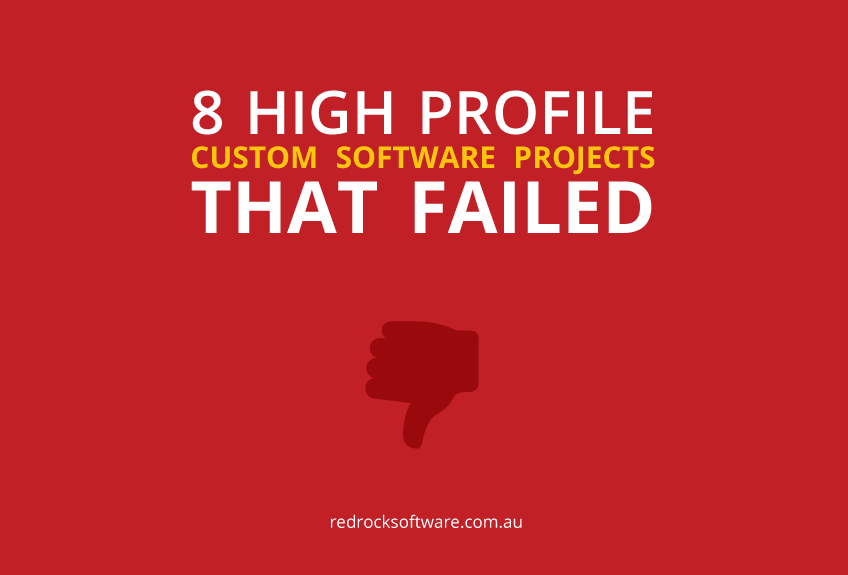
06 Nov 8 High Profile Custom Software Projects That Failed
Everything aspect of business comes with its risks- custom software development is no different. There are plenty of ways that small scale custom software projects can go wrong, and even more when the scope increases. For starters, choosing a software company that lacks experience and a good client history is a good way to get into trouble- however, some of these projects had well-known developers that still failed!
1. Starbucks: physical stores closed by digital problems
Much of the civilized business world runs on coffee. The United States’ coffee corporation is happy to provide it, efficiently, through their use of technology in stores. However, because of a software malfunction, 60% of all Starbucks worldwide had to close their stores. That’s 8100 stores that were unable to accept payments or conduct business of any kind- talk about a lack of a contingency plan. The benefits of having a sophisticated, client oriented POS system like the one Starbucks has are great- as long as it actually lets them accept payment. For more info:
2. A $1.2 billion “bungle” in Queensland
Maybe the government in Queensland should start looking for software development in Perth! The Queensland Health payroll system was described as a “bungle” that ended up costing taxpayers $1.2 billion. The software company they contracted to do the work has a pretty good history when it comes to computers and development: they chose IBM. There is a certain amount of finger pointing going on on both sides. For more details, see the government’s statement here.
3. The world’s largest civilian system abandonment
The National Health Services IT system in the U.K. was supposed to be the world’s largest civilian system, and now it’s one of the largest failures of all time. If you thought costing taxpayers $1.2 billion was bad- this was far worse. The failed NHS IT system ended up costing 10 billion pounds before being completely abandoned by the government. It was intended to create a centralized e-record system, but was unable to deliver on all fronts. The biggest cause of the problem appears to be human error. For more info
4. Universal Credit in the U.K.
Initial projections for the Universal Credit overhaul put the budget at £2.2 billion. However, recent findings have shown that it will more likely end up costing taxpayers £12.8 billion. The biggest problems came from a failure to see what was going wrong until it was to late. Reports from The Guardian state that there was a “culture of good news” in which no one could say what was going wrong. Computer Weekly has more details on this massive failure.
5. New York’s CityTime Failure
New York City needed a way to modernize its payroll system- way back in 1998. They decided to set aside $60 million USD for a software system capable of this undertaking. However, the project kept getting more and more complicated and more and more requirements kept adding on. Years later, the project sits at over $700 million- the Mayor even called it a “disaster.” The main problems seem to stem from a lack of planning in the beginning stages, as well as a lack of software understanding.
6. Nike knows shoes, but apparently not software
Although Nike has long since rebounded from this software hiccup, it’s an important lesson in ROI. They spent $400 million USD in an attempt to update their systems back in 2000. This included ERP, supply chain, and a large CRM project, all intended to be integrated into one system. However, it ended up costing them $100 million in lost sales, a 20% drop off in their stock price, and on top of that, lawsuits. CIO has more.
7. Vintage failure: TAURUS in the U.K.
Transfer and Automated Registration of Uncertificated Stock was intended to be a share trading system built for the London Stock Exchange way back 1983. It ended up costing £75M to the Exchange, and £400M to other stakeholders. The plan sounded simple enough: move away from paper stock trading and begin to utilize computers. The initial plan was scrapped in 1989- but the project still lingered for four more years, soaking up stockholder money with it. For more information, check out this article.
8. FBI’s Virtual Case File project
The FBI, the federal law enforcement of the United States, needed a system to connect all of its branches trying to solve potentially linked crimes. After four years and $105 million, they were forced to scrap the program. They didn’t even drop it in favor of another one: they just gave it up entirely. The problem was due mostly to mismanagement and software that became outdated before it was even released .
It might seem like the larger the project, the more risk there is when it comes to its chances of success. This is because larger projects have more requirements that need to be met, more budgets, and often, “too many cooks in the kitchen.” There’s no easy way to set up custom software for success, but a good plan, a good team, and a firm budget can all help.


